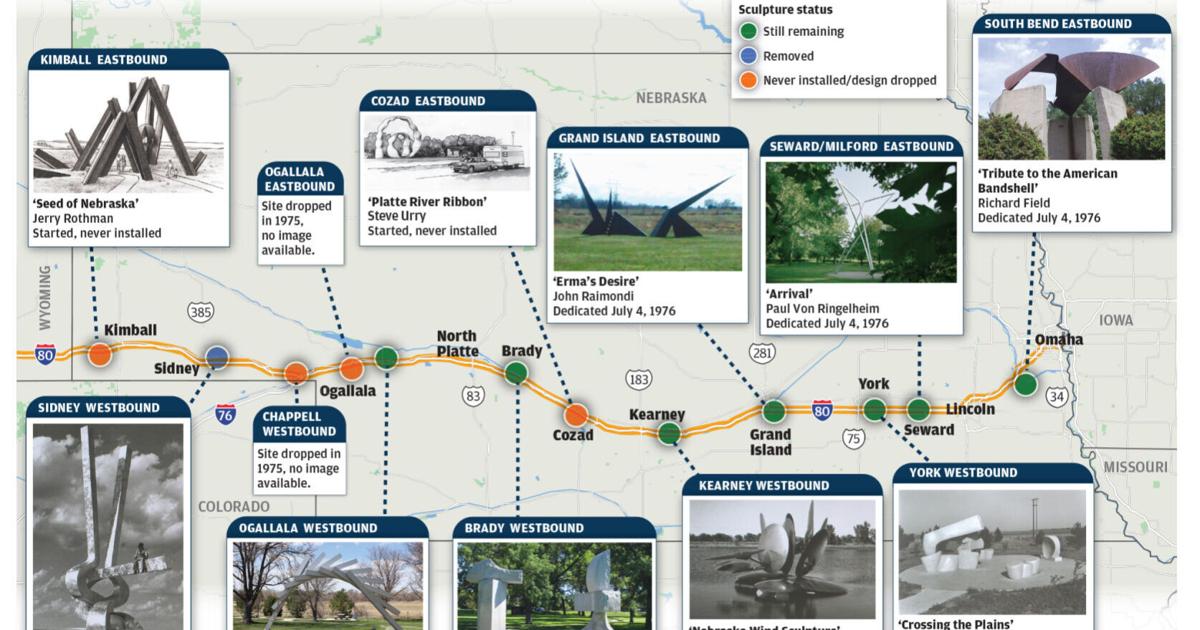As the nation approaches its Semiquincentennial in 2026, a distinctive chapter of Nebraska art history resurfaces: the Interstate 80 Bicentennial sculptures, now nearing their remarkable 50-year milestone and currently under consideration for the prestigious National Register of Historic Places. These monumental I-80 sculptures, conceived as a bold celebration of America’s bicentennial, have endured a half-century of varied public perception, transforming from objects of intense debate into cherished, if still sometimes puzzling, landmarks.
Unveiled in July 1975, the public art initiative immediately ignited a significant 1975 controversy that gripped Nebraska for six tumultuous months. The abstract designs of the I-80 Bicentennial sculptures, far from the traditional commemorative statues many expected, provoked strong reactions, deeply dividing opinions across the state. This initial uproar highlighted a perennial tension between avant-garde artistic expression and conventional public taste, making the artworks a focal point of statewide cultural discourse.
The heart of the debate stemmed from the abstract and unconventional forms chosen by the artists, challenging the prevailing notions of what “public art” should represent, particularly for a national commemoration. Critics questioned their aesthetic appeal and perceived lack of direct connection to Nebraska’s heritage or the bicentennial theme. Yet, proponents argued for artistic freedom and the power of abstract forms to evoke deeper reflection, positioning these I-80 sculptures as a modern expression of the nation’s evolving identity.
Despite the considerable public outcry, the I-80 sculptures remained steadfastly in place, gradually becoming an indelible part of the landscape along the heavily trafficked interstate. Over the decades, these once-contentious structures evolved from symbols of the 1975 controversy into familiar, if often pondered, milestones for countless travelers. Their enduring presence speaks volumes about the longevity of artistic vision and the eventual acceptance, or at least integration, of even the most debated pieces of public art into the communal fabric.
Fast forward to the present, and the narrative surrounding these unique pieces of Nebraska art has undergone a profound transformation. As the 2026 Semiquincentennial approaches, the I-80 Bicentennial sculptures are no longer merely objects of past contention but are recognized for their historical and cultural weight. This re-evaluation has culminated in their active consideration for inclusion in the National Register of Historic Places, a significant step that acknowledges their unique place in American public art history.
The potential designation for historic preservation would formally cement the I-80 sculptures’ legacy, recognizing them not just as artworks but as integral historical markers reflecting a specific moment in the nation’s bicentennial celebration and the evolving discourse around public art. Such an honor would ensure their continued maintenance and protection, safeguarding these resilient structures for future generations and validating their journey from initial public contention to esteemed cultural heritage.
From their stormy debut marked by the 1975 controversy to their current contemplation for national recognition, the I-80 Bicentennial sculptures embody a fascinating saga of public art, shifting perceptions, and enduring cultural significance within Nebraska art. Their story serves as a powerful testament to how time and perspective can transform even the most debated artistic expressions into valuable historical landmarks, underscoring the dynamic interplay between artistic creation and public reception.
Discover more from The Time News
Subscribe to get the latest posts sent to your email.





